Sound is an amazing thing. All the different noises we listen to are caused by minute pressure differences in the air around us. The air transmits those pressure and changes so well in a fraction of seconds and so accurately over relatively long distances.
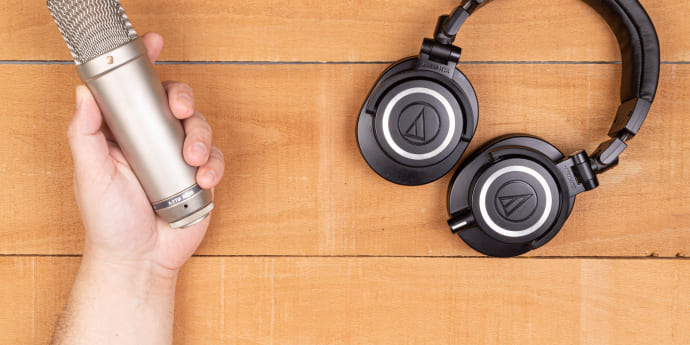
Then:
If we go deep into the history of mics, Alexander Graham Bell patented the first microphone in 1876. It consisted of a wire that conducted direct electrical current (DC). Audio signals were generated and received by a moving armature transmitter. The receipt and transmission was possible from both directions. Bell’s second transmitting device was a liquid transmitter, which he demonstrated at the Philadelphia Centennial Exposition of 1876. His creation utilized a variable contact principle to provide an effective method of electrical signal modulation than his previous microphone design.
Now:
The number of microphones in production houses or entertainment sector have increased so much. There are an overwhelming number of microphones in the market. Picking the best microphones is a serious and daunting task.
It doesn’t have to be as dizzying as it seems but choosing the best microphones but suiting your purpose aptly can be a real task.
Table of contents
- Microphone Polar Patterns
- Types of Microphones
- Jacks and connectors required for different types of microphones
- Here are some pro tips to the microphones cable care-
- Microphones used for Filmmaking, Vlogging and video production :
- Types of microphones for podcasters
- Types of microphones for video production –
- The Best Studio Mics For Vocals
- Best mics for different instruments
- Wrap up
Mechanism of Microphones –
Microphone Polar Patterns
Polar patterns describe how microphones pick up sound, showing specifically where mics ‘listen’ spatially and which positions are blocked. Having a good grasp of these polar patterns will help you select the right mics that capture the sound that you need while minimizing unwanted noise.
So, if you are known to the different types of microphones, you will be able to narrow down your choices you have to make for your purpose. Let’s dive into the types of microphones, their usage, and how to know if they are right for you.
Types of Microphones
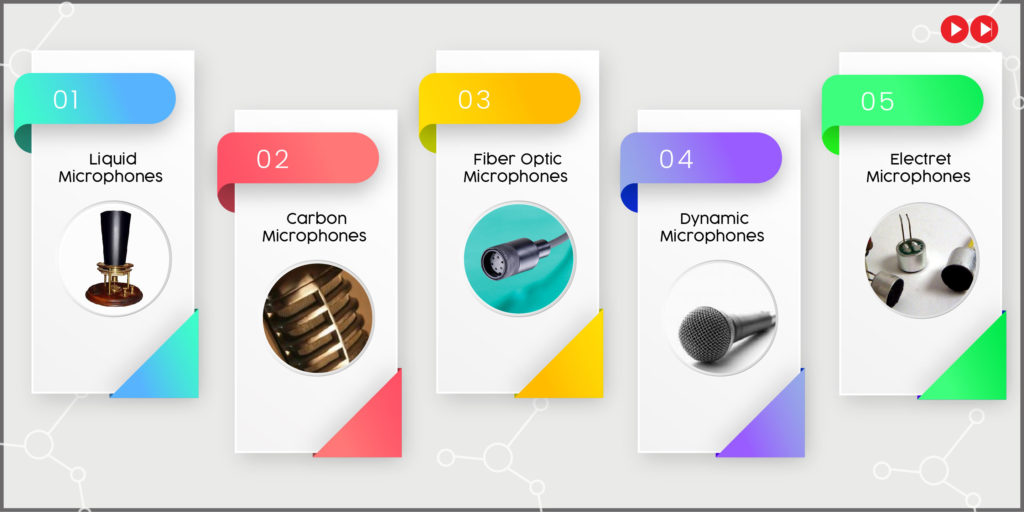
1. Liquid Microphones
Liquid microphones are said to be invented by Alexander Graham Bell and Thomas Watson. Both of them developed the first working microphones, and they were a precursor to what would later become the condenser microphone. Early liquid microphones were made of used metal cups filled with water and sulfuric acid. A diaphragm was placed over the cup with a needle on the receiving side of the diaphragm. Sound waves would cause the needle to move in the water. A small electrical current ran to the needle, which was modulated by sound vibrations. Since evolution, a liquid microphone was never particularly functional, but it helped in a great science experiment.
2. Carbon Microphones
The simplest and oldest microphone uses carbon dust. This is the technology used in the initial telephones and still is used in some telephones today. The carbon dust has a thin metal or plastic diaphragm on one side. As sound wave hits the diaphragm, it compresses carbon dust that changes its resistance. On running a current through the carbon, the changing resistance varies the amount of current that flows.
3. Fiber Optic Microphone
Fiber-optic systems are super-thin strands of glass that transmit information instead of traditional metal wires. Fiber optics are revolutionizing the field of telecommunications for the last past few years. It has also covered microphone technology. Unlike conventional mics, they are often big and send an electrical signal. Fiber optic microphones can be tiny that can be used in electrically sensitive environments. Those mics can also be produced with no metal, making them very useful in magnetic resonance imaging applications, just like other situations where radio frequency interference is an issue.
4. Dynamic Microphones
A dynamic microphone works on electromagnetic effects. When a magnet moves past, the magnet induces current to flow in the wire. A diaphragm moves either a magnet or a coil in a dynamic microphone and when sound waves hit the diaphragm, the movement creates small current. Small diaphragm condenser microphones are common for home recording or live performances. Distinguished by their appearance which is like a pencil, small diaphragm mics are less sensitive than large-diaphragm mics, and generally better at handling high pressure levels at wider dynamic ranges. While large-diaphragm mics are considered almost as instruments in itself, adding depth to sound.
Small diaphragm mics are correspondent to the tools that accurately record sounds as they are in real life. Large diaphragm condenser microphones are generally found in a professional recording studio set ups. It is because they pick up more vibrations from sound waves due to a larger diaphragm within the microphone. It allows them to detect faint differences in sound and reproduce it with a greater fidelity. Their sensitivity, means that they are liable to distortion at high pressures – by keeping a check on the volume and prevent it from happening. Dynamic microphones are reliable and versatile and are used in broadcasts, recording studios, or live performances.
The three types of dynamic microphones are –
- Cardioid: One can imagine a Japanese fan coming from the tip of the mic. That’s the pattern it will hear sound from.
- Super Cardioid: Means the fan is not fully unfurled with a tighter pickup area.
- Omni: means all around. Overall and from everywhere. Compare it with a globe. The pick up range is from 360 degrees and captures sound from all around the mic.
They work by transforming sounds waves into mic signals via a moving-coil magnetic diaphragm. It is a thin material that vibrates on contact with sound within the microphone. The diaphragm’s ability to move gives the dynamic microphone its versatility. It can capture sound at widely depending upon sound pressure levels. It deals with booming bass and guitar amplifiers unlike it does with quieter sounds. Dynamic microphones are one of the best types of microphones used in radio production. Looking at the functionalities, choose the best and make most out of microphone.
5. Electret Microphone
Electret microphones are widely used microphones. They are economical and relatively simple. Electret mics are used in cell phones and handsfree headsets. An electret microphone is similar to a condenser microphone. It has an external charge which is replaced with an electret material, which is by definition, a permanent state of electric polarization.
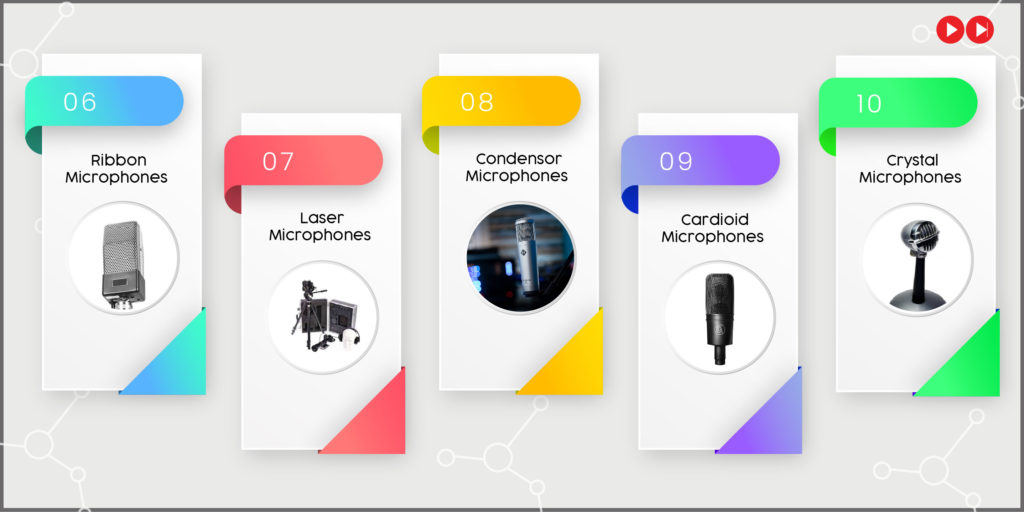
6. Ribbon Microphones
Invented in the 1920s, ribbon microphones were once synonymous with the broadcast radio. They are used today as well to produce a retro sound. Just like diaphragm microphones, ribbon microphones pick up sound waves through a thin, corrugated metal strip, suspended between two magnetic poles. They respond directly to the velocity of air particles than changing in pressure. It makes it a good choice for recording in high frequencies. Ribbon microphones are bidirectional which means they pick up sounds from both sides of the mic. The use of metal strip as a receptor for the sound waves also means that the ribbon microphones are naturally bi-directional. And hence, block out sound waves coming to the sides of the microphone. A thin ribbon is used in a microphone — usually made of aluminum, duraluminum or nanofilm. Which is suspended in a magnetic field. Sound waves moves the ribbon on the current flowing through it.
The first ribbon microphone was RCA PB-31. It was produced in 1931 and changed the audio and broadcasting industries. It is because it set a new standard after coming to clarity. Several other microphones include the BBC-Marconi Type A and ST&C Coles 4038 made by makers for a comparable model.
7. Laser Microphone
A laser microphone works by capturing vibrations off of a plane, like a windowpane and transmitting the signal back to a photodetector. Which then converts the reflected laser beam into an audio signal. When sound hits the windowpane, it bends and causes the laser beam to bend. It can then be translated to sound using a photocell. In recent few years, scientists have been developing a new type of laser microphone which works by streaming smoke across a laser beam. On aiming it at photocell is when it is converted to an audio signal, producing sound.
8. Condensor Microphones
A Condenser microphone has a capacitor with single plate of the capacitor moving to respond to sound waves. The movement changes the capacitance of the capacitor, and the changes are amplified to create a measurable signal. Condenser microphones usually need a small battery for functioning.
9. Cardioid Microphone
The cardioid microphone helps record sound located in front of and on the sides of a mic and not behind it. It is heart-shaped, so is the name with the highest sensitivity situated in front of the mic and slightly less on the sides. Cardioid mics are ideal for recording live performances. It doesn’t capture too much crowd noise happening in the background. Many artists have handheld microphones used to amplify vocals are cardioid mics only.
10. Crystal Microphones
Some crystals change their electrical properties as they change shape. By attaching a diaphragm to a crystal, it creates a signal when sound waves hit the diaphragm. Every technology imaginable harnessed to convert sound waves into electrical signals in mics. Most have in common the diaphragm that gathers the sound waves and creates movement in whatever technology is used to create the signal.
Jacks and connectors required for different types of microphones
A microphone acts as a transducer that converts sound waves into audio signals. With a list of types of microphones we described above, you must have got the fair idea of having one for your purposes. They are needed to plug into mixers/recorders, into a playback system to be heard and truly enjoyed by the listener.
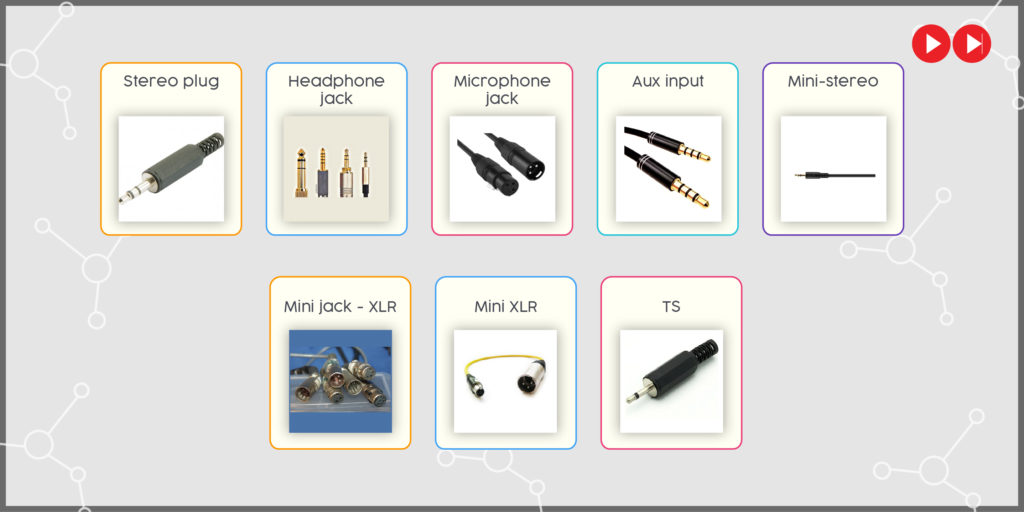
Microphones typically are plugged into mic preamplifiers. It can be standalone devices or built into mixers, recorders, interfaces, etc. Mics can plug into any audio input with the optimum connection.
Specific models of mics need special connectors and jacks. Some special types of microphones jacks are termed as –
- Stereo plug
- Headphone jack
- Microphone jack
- Aux input, etc. 3.5 mm versions are commonly called mini-phone
- Mini-stereo
- Mini jack – XLR (3-pin, 5-pin, 7-pin, or other variants)
- Mini XLR (TQG, TA3, TA4)
- TS (2.5mm, 3.5mm (1/8″), or 1/4″)
- TRS (2.5mm, 3.5mm (1/8″), or 1/4″)
- TRRS (2.5mm, 3.5mm (1/8″), or 1/4″)
- TA5
- Tube Power Supply
- Switchcraft 2501F
- Nexus
- Amphenol Tuchel
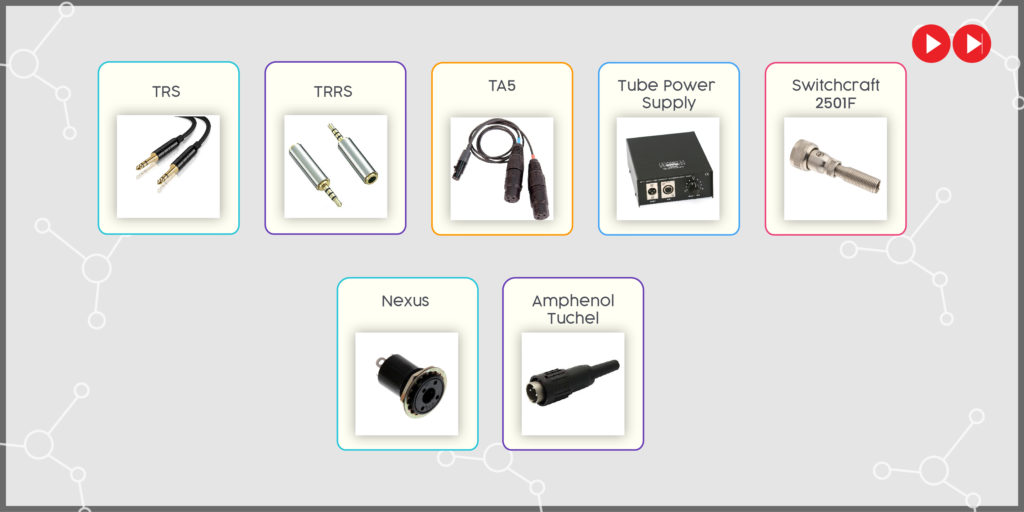
Here are some pro tips to the microphones cable care-
- Use natural looping of the cable.
- Never wrap cable around your bent arm or in a tight figure eight pattern.
- Avoid twists and kinks that damage the cable or keep it from laying flat
Microphones used for Filmmaking, Vlogging and video production :
Musicians, filmmakers and vloggers love to create content for their listeners and audiences. Market is loaded with tones of short videos apps to make short videos. No second thought that editing is an essential part of the entire video making process.
Things that are required to shoot small videos are digital cameras and smartphones. A device that can capture good audio to some degree. Types of mikes used by a Youtuber, and vloggers are built-in microphones, mostly. They tend to record at an extremely lower quality than a dedicated microphone. But a professional Youtuber who is seriously in the business uses good quality mikes for vlogging. No matter if you are shooting indoors or outdoors, noise disturbances can be a ruinous problem. Choose wisely depending on your requirement.
Types of microphones for podcasters
The one best microphone used by the podcasters out of others is Shure MV7. One of the best type of microphone on its own, Shure MV7 stands topmost for a number of reasons. It combines the dual benefits of USB and XLR recording and allows it to be used simultaneously. It has made one of the best podcasting microphones you can lay your hands on.
Types of microphones for video production –
A lapel mic or lavalier mic is the gold standard mic for capturing dialogue and vocals. A lapel captures incredible audio while conducting an interview for television, documentary film, or industrial video. Commonly used by video makers or big production houses, lapel mics are the best in its own kind. Lapel mic or Lavs come in a wired and wireless version. Both versions are small and portable enough to place and hide under the shirt’s collar or inside the shirt. Commonly seen placed on the chest region of TV anchors, these mics are super light in weight. In order not to move the mic, a little gaffer tape is required to stick the mic on the shirt region.
The Best Studio Mics For Vocals
Once you reach a certain point in your exploration of music production, you will start to feel the limitations of your starter gear. Using a less-than-optimal vocal mic makes you do more things during mixing. It inevitably gives you an inconsistent sound, especially with vocals. Every individual’s voice is different. This means that, single mic may not be optimal or comfortable for any given singer/video maker/blogger/vlogger to use. So, to cater every voices there requires different types of audio recording microphones suiting different voices. There are various mikes that a sound producer uses. Different types of audio recording microphones helps to use mic that alters the singer’s voice in an undesirable way in order to get good performances. A good quality vocal mic enables singers to perform better and get great reactions from the crowd.
Drum Mic Kits
Talking specifically about the music industry, the most identifiable characteristic that give each studio a “sound” and identity is the sound of their drum recordings. Many established studios have a “house sound”, with drums. The prominent way to get started with achieving your signature sound is by getting a full, multi-piece drum mic kit. Know the different mics used for instruments-
Best mics for different instruments
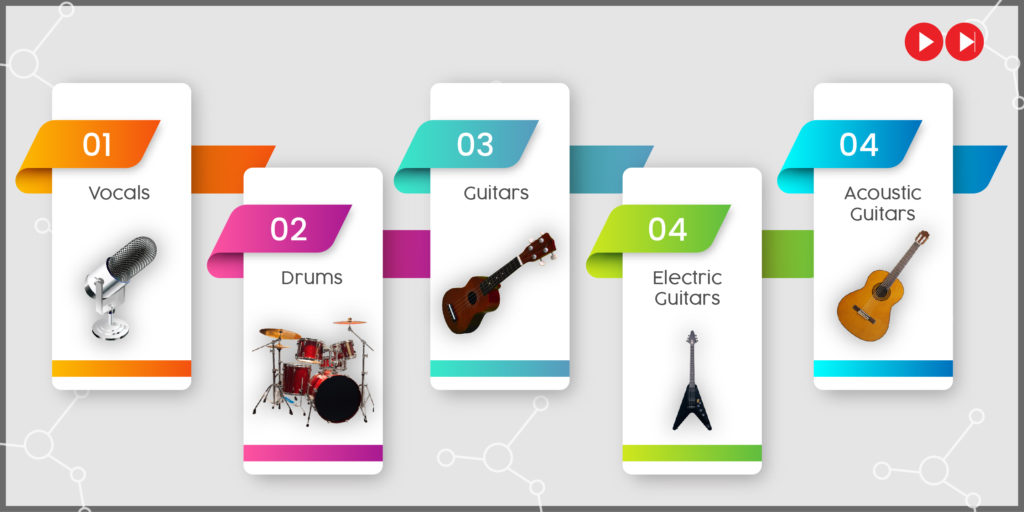
VOCALS
The most reliable option for recording vocals is a large-diaphragm microphone. Vocals’ sensitivity and range means that it can deal with all types of singing voice and style. A ribbon microphone can be deployed to create a more vintage sound. While a small diaphragm or ‘shotgun’ mic can be used for capturing groups of singers in a show in large and open venues.
DRUMS
Dynamic mics are the best to capture different sounds produced by a full drum set. Right from the bass to the snare and toms. To get the nuances of more high-pressure sounds, a series of small-diaphragm mics can be used.
GUITARS
It depends on if the guitar is acoustic or electric. For electric guitars, a dynamic mic placed in front of the amp – as long as it’s cardioid or hyper-cardioids can deal with the high-pressure frequencies. For acoustic, on the other hand, a large-diaphragm mic will help to capture softer, more intimate sounds with larger fidelity.
ELECTRIC GUITAR
Close mics guitar amplifiers are so loud at times louder than drum kits. It requires mics that can handle high SPL. A well-positioned cardioid or hyper-cardioid dynamic mic in front of the amp speaker. A second condenser mic or ribbon mic, is set back at a distance. It can be used if you are using multiple amps or a warmer, more classic sounding output. When in combination with a close mic, it captures some of the room ambiences.
ACOUSTIC GUITAR
Acoustic guitars, have a softer sound when not amplified with immersive nuances. Acoustic guitars require the fidelity and quality of large diaphragm condenser mics.
Setting up an extra small diaphragm mic works wonder in capturing the higher frequencies that sometimes get lost when acoustics are plugged in or miked directly upfront.
Wrap up
We’ve walked you through main types of microphones you’ll use in various situations. Singing, recording or dubbing. However, as you gain some experience, you’ll be in a position to learn how to break the conventional way of using a microphone for your purposes. Believe it or not, there are several other microphones available in market for various purposes. Choosing the right quality microphone for the appropriate purpose can go a long way to ensuring that your speakers/ singers are heard loud and clear without any distraction.
If there’s anything more you would like to know about microphones then please feel free to ask in the comments below.









